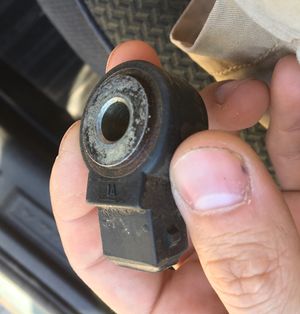
P0328 Knock sensor circuit high input
Content
Trouble Code P0328 OBD-II Datasheet
P0328 - This is a code that indicates a high input signal in the knock sensor 1 circuit (bank 1 or a separate sensor)
Code P0328 tells us that the bank 1 knock sensor 1 input is high. The ECU is detecting excessive voltage that is out of range of the knock sensor. This will cause the Check Engine light to appear on the dashboard.
What does this mean?
This Diagnostic Trouble Code (DTC) is a generic transmission code, which means it applies to OBD-II equipped vehicles. Although general, specific repair steps may differ depending on the brand / model.
Knock sensors are used to detect engine pre-knock (knock or horn). The knock sensor (KS) is usually two-wire. The sensor is supplied with a 5V reference voltage and the signal from the knock sensor is returned to the PCM (Powertrain Control Module).
The sensor signal wire tells the PCM when knocking occurs and how severe it is. The PCM will slow down ignition timing to avoid premature knock. Most PCMs are capable of detecting spark knock tendencies in an engine during normal operation.
Code P0328 is a generic trouble code so it applies to all makes of vehicle and refers to a knock sensor high output voltage. In many cases this means that the voltage is higher than 4.5V, but this specific value depends on the specific make and model of the vehicle. This code refers to the sensor on bank #1.
Symptoms
Symptoms of a P0328 trouble code may include:
- MIL Illumination (Malfunction Indicator)
- Sound knock from the engine compartment
- Engine sound when accelerating
- Loss of power
- Irregular RPM
Causes of the P0328 code
Possible causes of a P0328 code include:
- Knock sensor connector damaged
- Knock sensor circuit open or shorted to ground
- Knock sensor circuit shorted to voltage
- The knock sensor is out of order
- Loose knock sensor
- Electrical noise in the circuit
- Low fuel pressure
- Incorrect fuel octane
- Mechanical motor problem
- Faulty / faulty PCM
- Open or short circuit in knock sensor circuit wiring
- Defective ECU
Possible Solutions to P0328
If you hear engine knocking (knocking), first eliminate the source of the mechanical problem and recheck. Make sure to use fuel with the correct octane rating (some engines require premium fuel, see Owner's Manual). Other than that, for this code, the problem is likely to be either with the knock sensor itself or with the wiring and connectors going from the sensor to the PCM.
In fact, for a DIY car owner, the best next step would be to measure the resistance between the two terminals of the knock sensor wires where they enter the PCM. Also check the voltage at the same terminals. Compare these numbers with the manufacturer's specifications. Also check all wiring and connectors from the knock sensor back to the PCM. In addition, you should also check the resistance with a digital volt ohmmeter (DVOM) of the knock sensor itself, compare it to the vehicle manufacturer's specification. If the resistance value of the knock sensor is not correct, it must be replaced.
Other Knock Sensor DTCs include P0324, P0325, P0326, P0327, P0328, P0329, P0330, P0331, P0332, P0334.
HOW DOES A MECHANIC DIAGNOSTIC CODE P0328?
- Uses a scan tool connected to the vehicle's DLC port and checks for codes along with the freeze frame data associated with the codes.
- Clears codes and test drives vehicle to reproduce symptoms and code.
- Stops engine knock
- Performs visual inspection and looks for errors
- Checks the cooling system and engine for faults
- Check fuel octane and fuel system if engine knocks.
- Uses a scan tool to monitor knock sensor voltage changes when the engine is not knocking.
- Uses a scan tool to check coolant temperature and fuel pressure.
- Checks the control unit, each car has its own procedure for checking the control unit
One comment
Ricky
The p0328 knock sensor has been replaced but the problem still occurs, the check engine light is still on